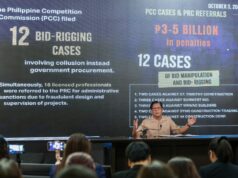Analysts expect Bangko Sentral to cut reserve requirement ratio
By Melissa Luz T. Lopez, Senior Reporter
More market watchers are growing certain that the Bangko Sentral ng Pilipinas (BSP) will kick off the year with cuts to bank reserves prior to any policy rate adjustments.
In separate analyses, ING Bank N.V.-Manila, HSBC Global Research, and the First Metro Investment Corp. (FMIC) said the central bank is unlikely to touch key rates during their policy meeting next week, with the focus shifting to the reserve requirement ratio (RRR).
ING senior economist Nicholas Antonio T. Mapa took the cue from BSP Governor Nestor A. Espenilla, Jr.’s speech last week, where he said the central bank now sees “scope” for a further reduction in the required reserves given that inflation is crawling its way back to the 2-4% target from a peak of 6.7% last year.
“Touting inflation on a deceleration trend and seemingly well-anchored inflation expectations, the Governor may be prepping the market for another round of cuts to his RRR as he looks to accomplish his agenda,” Mr. Mapa said.
“The latest reading for domestic liquidity growth shows money supply grew 8.4% in November, the third straight month of single digit growth giving the Governor a reason to flood the market with an additional P90 billion.”
From a global high of 20%, the central bank slashed the RRR in two moves last year and now require universal and commercial banks to hold on to just 18% of their deposits, leaving them with more or less an additional P200 billion which they can lend to borrowers.
Mr. Espenilla’s long-term goal is to bring the bank reserve standard to single-digit by 2023 or when his six-year term as central bank chief ends.
The BSP has long clarified that any RRR cut signifies an “operational” change rather than a shift in their policy stance, although market players view it as an easing.
Instead, the reductions seek to trim costs of borrowing money in the local financial system. However, Mr. Espenilla said last year that they will put further reserve cuts in the back burner as surging consumer prices became the BSP’s top concern, which kicked off five rate hikes worth a total of 175 basis points (bp).
HSBC economist Noelan Arbis said he expects the Monetary Board to keep rates steady at the 4.25-5.25% range during their Feb. 7 meeting, adding that policy makers have room to stay on hold for the entire year “barring upside surprises to inflation.”
From 5.2% in 2018, the central bank expects inflation to decline further to average 3.2% this year, marking a return to its target range. Ahead of next week’s review, BSP Deputy Governor Maria Almasara Cyd Tuaño-Amador hinted that policy makers have room to pause on rate hikes with inflation now decelerating.
Mr. Arbis expects the RRR to drop by 300 bps by yearend, with a one percentage point cut for the next three quarters.
“We expect RRR cuts to take precedent over any policy rate cuts. The effectiveness of interest rate cuts to stimulate growth are limited given a rising loan-to-deposit ratio, which has reached 78.2% as of 3Q18,” Mr. Arbis said.
“This means that a reduction in RRR is first needed to bolster the effect of any monetary policy loosening.”
Some economists have noted that the 4.75% key borrowing rate — the highest in a decade — could dampen domestic activity and hurt economic growth, thus the need to unwind the series of tightening moves last year.
For its part, analysts at FMIC said an interest rate cut will follow an RRR adjustment.
“Our view that BSP will cut reserve requirements by Q1-2019 to meet liquidity needs of banks and cut policy rates by H2 as inflation goes below 3% (year-on-year) provide financial support to this fairly optimistic outlook,” the economic research firm of the Metrobank Group said in their January issue of The Market Call.
In turn, this should boost the Philippine economy to grow by 6.8-7.2%, coming from a disappointing 6.2% finish in 2018. If realized, this would mean that the low end of the state’s 7-8% growth target may be doable.



